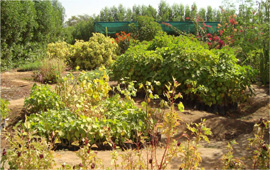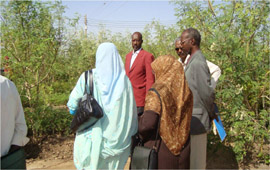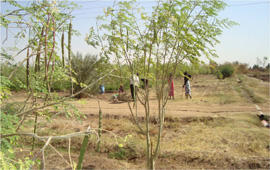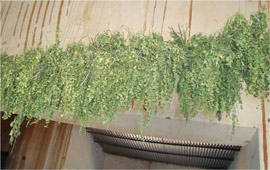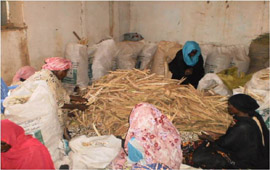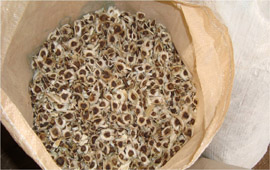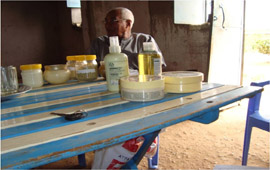Effective microorganism (EM) technology
Perspectives for technology transfer
 ATTS is advocating for effective microorganism (EM) technology . EM is a combination of various beneficial, naturally occurring, microorganism
used or found in food.
ATTS is advocating for effective microorganism (EM) technology . EM is a combination of various beneficial, naturally occurring, microorganism
used or found in food.
Experiments done using EM in agriculture (2008- 2010)
2008:
1-Tomato in Elsagai (Khartoum North).
2- Sun Flower and Zea maize in Zad Alkhier (Wad Raawa).
2009:
1- Land Escape in Dal Khartoum.
2- Galia Melon (Seeliat Shemal).
3- Green Beans (Dabak).
4- Potato (Elkhoglab).
2010:
1- Ground Nuts (Fool Sudani) in Gazera and Elmanagel.
2- Dorah (Sorgum) in Gazera and Elmanagel.
3- Tomato in Elmanagel.
Observations
1- Decrease in harvesting time by about 30% - 40%.
2- Increase in the total yield by almost 100%.
3- Upgrading quality ,increase in size, product is more healthy and as a result shelf life is extended
4- Increase in the total contents of the product and free from infectious diseases
ATTS Agroforestry Project
Planting Moringa and Jatrofa
 ATTS is advocating for a moringa/ jatrofa agroforestry, model which has proven to be successful to address the challenges of:, alleviating poverty, securing livelihoods and economically empowering women, in a successful partnership with local communities, academic, private sectors and national financial institutions.
ATTS is advocating for a moringa/ jatrofa agroforestry, model which has proven to be successful to address the challenges of:, alleviating poverty, securing livelihoods and economically empowering women, in a successful partnership with local communities, academic, private sectors and national financial institutions.
The pilot project utilized an area of 3 feddans in Khartoum North, 5km North of the capital City of Khartoum with the aim to be replicated in other states of Sudan utilizing a microfinance investment. The pilot project initially planted an area of 3 feddans (1 feddan = 0.42 ha). The area is enough to be managed by one family and would fulfil their need of cereal and vegetable consumption.
Moringa trees were planted along side ridges of the watering canals together with the vegetables and main cereal crops, preferred at each particular location. Jatrofa is used as a life fence.
Moringa is a multipurpose tree known for nitrogen fixing, grows best in dry sandy soil and is drought resistant; it provides shade, nutritious food, medicine and oil for cooking and other products and can even purify and clarify water. The leaves are harvested to be sold as green tea and the stripped branches as animal fodder together with seed pods. The seeds are also sold to private sector, or crushed and sold as oil used for cooking and the cakes as animal feed. The model also includes provision of livestock and continuous supply of water. Jatrofa is used as biodiesel, lighting and soap making.
Implementation in rural areas will target groups of ten families on 30 feddans where a well will be drilled and shared by ten families who are asked to be com
anised in a farmer association. The project is linked with the Central Bank microfinance in support of the intervention.
Clean Development Mechanism & Carbon Finance
 Under the UN Framework Convention on Climate Change (UNFCC) that industrialized countries – who are responsible for the vast majority of emissions that cause climate change – should take the first steps towards sustainable energy consumption, use of clean technologies and sustainable land management practices, which are needed to mitigate the impacts of climate change. CDM allows developed countries to generate ‘carbon credits’ (Certified Emission Reductions, CERs) in developing countries
Under the UN Framework Convention on Climate Change (UNFCC) that industrialized countries – who are responsible for the vast majority of emissions that cause climate change – should take the first steps towards sustainable energy consumption, use of clean technologies and sustainable land management practices, which are needed to mitigate the impacts of climate change. CDM allows developed countries to generate ‘carbon credits’ (Certified Emission Reductions, CERs) in developing countries
Agriculture Technology Transfer Society (ATTS) in association with Core CarbonX Solutions Private Limited is launching a small scale Programme of Activities (POA) which involves the installation of Domestic Biogas plants for the households in Sudan under the Clean Development Mechanism (CDM) of United Nation Framework Convention on Climate Change (UNFCCC). Under the POA the small scale projects under the above mentioned category will be developed. The first CDM Programme of Activity (CPA) has been proposed at North Kordofan under the POA. The POA and CPA intend to reduce the amount of fuel wood and agriculture residues used for cooking with cleaner biogas and also reduce methane emissions from the animal manure and will contribute strongly to the sustainable development of the rural households involved in the project.The POA and CPAs would contribute to the global efforts towards combating global warming. In order to understand the concerns and opinions of the local stakeholders a consultation meeting was held at Policeman Headquarter Hall on 21 March 2013 at 9.00 AM.
The first milestone concerning a questionnaire was completed. The project documentation was delivered to the designated national authority (DNA) at the higher council for environment and natural resources for the issuance of letter of approval. Next milestone will deal with validation and verification.
ATTS Projects Gallery
Clean Devlopment Mechanism CDM
Women empowerment
Energy at household level
 The main source of energy source at house cooking is fuel wood which constitutes one of the major causes. ATTS could introduce technologies such as:
The main source of energy source at house cooking is fuel wood which constitutes one of the major causes. ATTS could introduce technologies such as:
1- Improved stoves
2- Solar cooker
3- biogas.
Most farmers abandoned their fields, pasture areas shrank due to the thick canopy of Mesquite
food processing
Since women will be assisted in home garden activities, food processing would include beside drying other methods such as making jams, marmalades and syrup. Surplus milk could be processed for cheese and ghee
Women leadership
Women leadership could be strengthened through workshops, the purpose is to empower the role of women in natural resources management and enforce their role in conflict resolutions.
Technology to be adopted in home garden plantation
The Bioreclamation of Degraded Lands (BDL)
The International Crops Research Institute for the Semi-Arid Tropics (ICRISAT) is a non-profit, non-political organization that does innovative agricultural research and capacity building for sustainable development with a wide array of partners across the globe. ICRISAT’s mission is to help empower 644 million poor people to overcome hunger, poverty and a degraded environment in the dry tropics through better agriculture. ICRISAT belongs to the Alliance of Centers of the Consultative Group on International Agricultural Research (CGIAR).
The BDL is an innovative production system of horticulture crops that provides solutions to a range of critical constraints affecting the livelihood of the rural population of the Sudano Sahel. Because of its simplicity and its many positive attributes the potential for its mass-adoption is very high.
Food Security
Mega programmes (MP)
 Mega programs are new trends integrating various research disciplines with objectives:
Mega programs are new trends integrating various research disciplines with objectives:
1. Create and accelerate sustainable increases in the productivity and production of healthy food by and for the poor. (Food for People)
2. Conserve, enhance, and sustainably use natural resources and biodiversity to
improve the livelihoods of the poor in response to climate change and other
factors. (Environment for People)
3. Promote policy and institutional change that will stimulate agricultural growth and equity to benefit the poor, especially rural women and other disadvantaged
groups. (Policy for People)
.
Activities
Agriculture for improved food security, diet quality, and nutrition focuses on making nutritious foods more available and accessible to the poor throughout the year. Nutritious foods include animal-source foods (fish, meat, eggs, and dairy products), fruits and vegetables, biofortified staple foods, and wild foods with high nutrient content.
Strengthen food systems that increase the availability and accessibility of nutritious foods such as animal-source foods, fruits and vegetables, biofortified foods, and wild foods.
Use agrobiodiversity to improve nutritional diversity. The first set of activities in this area will assess patterns, levels of use, and the role of local biodiversity in people’s diets. This information will be used to develop and evaluate approaches aimed at enhancing current use of local foods (including local crops, indigenous vegetables, animals, and wild fruits) to contribute to greater dietary diversity and increase the availability of nutritious crops for production and consumption year round by vulnerable populations,
Develop tools to increase the demand and supply for nutrient-rich foods along the value chain, including bio-fortified staples as well as local foods from agro-biodiversity and from open-access and common property resources (such as fisheries, non-timber forest products, and wild foods). The goal of this activity is to educate consumers, producers, and other value-chain actors in the production, processing, preparation, and consumption of nutritious foods..
Rangeland Aspects
 The project proposed that, the reservation of sufficient amounts of supplemental feed is essential so that animals can rebuild their strength during drought, the primary objective in supplementary feeding is to minimize the loss of animals. The feed reserve can be improved by increasing hay making, sown fodder, feed manufacturing, and increasing indigenous plant feed preparation. Establishment of cultivated pasture will reduce the livestock dependency on nature and climate. A successful implementation of this measure would greatly reduce not only the expected impact of climate change but also the vulnerability to drought and harsh environment. However, ownership/possession of land often increases investment, as the land would be managed as a capital, in which investments must be made to promote sustainability and prevent land degradation. Therefore, cultivated pasture development would be feasible in the case in which the land tenure is legally certified. On the other hand, the measure is costly because it will require sufficient irrigation, good seeds, and application of fertilizers. Increased vegetation cover of pasture by different varieties of perennials that are tolerant to drought is also a good adaptation option to increase pasture yield and restoration of degraded pasture. The feasibility of this measure depends on seed availability for such varieties of perennial pastures. The willingness of agropastoralists to bear the responsibility is also important. Expansion and rehabilitation of pasture water supply are other promising measures for improved pasture utilization and stock survival, as well as ecosystem conservation and rural development. Research, training, strengthening, and building upon existing capacity might be the most important measure in strengthening the adaptive capacity and enhancing the quality of life, in general. It is also important that more feasible and workable instruments are devised to influence local habits and traditions for the successful implementation of adaptations. This can be reached by educating agropastoralists and increasing their awareness with respect to environmental degradation and climate change. Research and training must be maintained and expanded at the pastoralists’ level. Improvement of the forecasting and warning systems is also essential. Increased disaster forecasting, especially drought would, however, help in preparing to meet potential dangers.
The project proposed that, the reservation of sufficient amounts of supplemental feed is essential so that animals can rebuild their strength during drought, the primary objective in supplementary feeding is to minimize the loss of animals. The feed reserve can be improved by increasing hay making, sown fodder, feed manufacturing, and increasing indigenous plant feed preparation. Establishment of cultivated pasture will reduce the livestock dependency on nature and climate. A successful implementation of this measure would greatly reduce not only the expected impact of climate change but also the vulnerability to drought and harsh environment. However, ownership/possession of land often increases investment, as the land would be managed as a capital, in which investments must be made to promote sustainability and prevent land degradation. Therefore, cultivated pasture development would be feasible in the case in which the land tenure is legally certified. On the other hand, the measure is costly because it will require sufficient irrigation, good seeds, and application of fertilizers. Increased vegetation cover of pasture by different varieties of perennials that are tolerant to drought is also a good adaptation option to increase pasture yield and restoration of degraded pasture. The feasibility of this measure depends on seed availability for such varieties of perennial pastures. The willingness of agropastoralists to bear the responsibility is also important. Expansion and rehabilitation of pasture water supply are other promising measures for improved pasture utilization and stock survival, as well as ecosystem conservation and rural development. Research, training, strengthening, and building upon existing capacity might be the most important measure in strengthening the adaptive capacity and enhancing the quality of life, in general. It is also important that more feasible and workable instruments are devised to influence local habits and traditions for the successful implementation of adaptations. This can be reached by educating agropastoralists and increasing their awareness with respect to environmental degradation and climate change. Research and training must be maintained and expanded at the pastoralists’ level. Improvement of the forecasting and warning systems is also essential. Increased disaster forecasting, especially drought would, however, help in preparing to meet potential dangers.
Value chains, linking producers to the markets
 The main objectives of the Fund are to reduce rural poverty, improve nutrition and increase food production. It cannot be judged or realized in terms of pure economic indicators, such as food production or agricultural growth rates. Certainly Fund projects must meet reasonable standards of economic viability, it extends to the traditional cost-benefit criteria to social objectives.
A value chain perspective takes a broader view of development than the traditional focus on simply improving technical efficiency and productivity in animal product supply chains. That traditional focus emphasizes the product itself, whereas the value chain perspective shifts the emphasis to its value. It recognizes that stimulating production and income generation for the poor can be driven by opportunities to add value to animal products and that these opportunities are typically set within complex webs of actors and activities which require a range of technical and institutional strategies.
Value chains are often described by identifying the various actors involved along the product's path from farm to consumer, but the value chain concept goes well beyond describing the structure of the chain to understanding how each actor and activity add value to the product and to what degree they benefit from that service or function. How much each actor benefits is likely to depend on how relationships among the various actors are governed and the market power held by the actor..
The main objectives of the Fund are to reduce rural poverty, improve nutrition and increase food production. It cannot be judged or realized in terms of pure economic indicators, such as food production or agricultural growth rates. Certainly Fund projects must meet reasonable standards of economic viability, it extends to the traditional cost-benefit criteria to social objectives.
A value chain perspective takes a broader view of development than the traditional focus on simply improving technical efficiency and productivity in animal product supply chains. That traditional focus emphasizes the product itself, whereas the value chain perspective shifts the emphasis to its value. It recognizes that stimulating production and income generation for the poor can be driven by opportunities to add value to animal products and that these opportunities are typically set within complex webs of actors and activities which require a range of technical and institutional strategies.
Value chains are often described by identifying the various actors involved along the product's path from farm to consumer, but the value chain concept goes well beyond describing the structure of the chain to understanding how each actor and activity add value to the product and to what degree they benefit from that service or function. How much each actor benefits is likely to depend on how relationships among the various actors are governed and the market power held by the actor..
Awareness raising
 Pastoralist communities constitute large percent of rural inhabitants and should be given special consideration:
The livelihood of pastoralists is highly dependent on the cash income derived from livestock and livestock products. Alleviating constraints to marketing, improving market information and upgrading marketing infrastructures will potentially increase the welfare of producers and urban consumers and improve the national balance of payments. The more pastoralists are aware of the market demand and price, the higher will be their bargaining power that could improve their income through getting a larger share of the market margining. Market infrastructural and institutional set-ups will improve the access of producers to potential markets and raise the household income and purchasing power of producers and local traders, which in turn will create positive impacts on the local economy. On the other hand, when income of the producers increases through better access to information, market and infrastructure, they could improve production, both in terms of quantity and quality, thereby benefiting consumers.
.
Pastoralist communities constitute large percent of rural inhabitants and should be given special consideration:
The livelihood of pastoralists is highly dependent on the cash income derived from livestock and livestock products. Alleviating constraints to marketing, improving market information and upgrading marketing infrastructures will potentially increase the welfare of producers and urban consumers and improve the national balance of payments. The more pastoralists are aware of the market demand and price, the higher will be their bargaining power that could improve their income through getting a larger share of the market margining. Market infrastructural and institutional set-ups will improve the access of producers to potential markets and raise the household income and purchasing power of producers and local traders, which in turn will create positive impacts on the local economy. On the other hand, when income of the producers increases through better access to information, market and infrastructure, they could improve production, both in terms of quantity and quality, thereby benefiting consumers.
.
Asset-Based Community Development (ABCD)
 As promoted by the British Department of International Development (DFID) and the United Nations Development Program (UNDP), the sustainable livelihoods approach has three essential features. Firstly, as a framework for analysis, it draws attention to the full range of assets that people draw upon to compose a livelihood, namely human, natural, financial, physical, and social and/or cultural assets. Secondly, as an instrument for policy and program design to reduce vulnerability, it emphasizes a holistic understanding of development so that an adequate asset mix can be created, sustained, and transferred from one generation to the next, a feature which has now translated into policies and programs dedicated to asset-building for sustainable livelihood outcomes. Thirdly, it puts people in the community at the centre as the principle agents of development, acting through community based organizations to collaborate with various other agents such as local government, NGOs, and the private sector
In a related sense, assets are also the basis on which people take action; they can empower people to challenge the structures that determine the way in which resources are allocated. However, these assets cannot be activated without access to them. Social capital is therefore a particularly important asset because it provides access to other assets, and it is access that is the most critical resource of all.
(ABCD) offers a set of principles and practices to mobilize and sustain community economic development. Connections between these principles and practices will take into consideration (i) current interest in sustainable livelihoods as a conceptual framework, (ii) the concept of social capital, (iii) the social psychology of mobilization, (iv) the enhancement of capacity and agency to engage as citizens with the entitlements of citizenship, (v) the role of multiple stakeholders; and (vi) the issue of control over the development process.
As promoted by the British Department of International Development (DFID) and the United Nations Development Program (UNDP), the sustainable livelihoods approach has three essential features. Firstly, as a framework for analysis, it draws attention to the full range of assets that people draw upon to compose a livelihood, namely human, natural, financial, physical, and social and/or cultural assets. Secondly, as an instrument for policy and program design to reduce vulnerability, it emphasizes a holistic understanding of development so that an adequate asset mix can be created, sustained, and transferred from one generation to the next, a feature which has now translated into policies and programs dedicated to asset-building for sustainable livelihood outcomes. Thirdly, it puts people in the community at the centre as the principle agents of development, acting through community based organizations to collaborate with various other agents such as local government, NGOs, and the private sector
In a related sense, assets are also the basis on which people take action; they can empower people to challenge the structures that determine the way in which resources are allocated. However, these assets cannot be activated without access to them. Social capital is therefore a particularly important asset because it provides access to other assets, and it is access that is the most critical resource of all.
(ABCD) offers a set of principles and practices to mobilize and sustain community economic development. Connections between these principles and practices will take into consideration (i) current interest in sustainable livelihoods as a conceptual framework, (ii) the concept of social capital, (iii) the social psychology of mobilization, (iv) the enhancement of capacity and agency to engage as citizens with the entitlements of citizenship, (v) the role of multiple stakeholders; and (vi) the issue of control over the development process.





